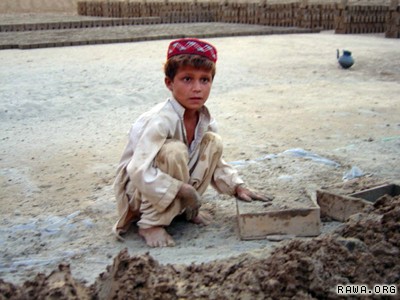IRIN, June 7, 2009
UNICEF: 24 Percent of Afghan Children Aged 7-14 are in Employment
According to the UN Children’s Fund (UNICEF), 24 percent of Afghan children aged 7-14 are in employment
Poverty, community pressure and the low quality of education mean 25 percent of children in Afghanistan aged 7-14 are at risk of leaving school and drifting into exploitative work situations, according to a new report by a Kabul-based think-tank.

25 percent of children in Afghanistan aged 7-14 are at risk of leaving school and drifting into exploitative work situations.
The report by the Afghanistan Research and Evaluation Unit (AREU), published in late May, included a number of recommendations for the government and NGOs: They should intervene to stop children from entering work, focus on improving the quality of education, and provide more employment opportunities for adults.
The cost of education, lack of role models and family pressures were cited as reasons why children often ended up being exploited in backstreet workshops, factories or as domestic servants.
“Child labour is a serious problem in Afghanistan, linked to the high incidence of poverty. While the study showed poverty alone does not drive families to put children into work, it does raise the risk that children will work. Inability to protect children… will have long-term implications for development in Afghanistan,” AREU director Paula Kantor told IRIN from Kabul.
Education quality and access played a key role in household decision-making about child labour, she added.
The shortage of professional teachers, books and convenient venues for education also has an impact on children leaving school prematurely, Fawad Sahil, external relations officer for UNICEF Afghanistan, told IRIN.
According to the UN Children’s Fund (UNICEF), 24 percent of Afghan children aged 7-14 are in employment.
In 1989 the UN General Assembly adopted the Convention on the Rights of the Child (CRC). Article 32: asserts the right of children not to be engaged in work deemed to be "hazardous or to interfere with the child's education, or to be harmful to the child's health".
Afghanistan is one of 14 countries which have not signed the International Labour Organization 1999 Convention 182 on the Elimination of the Worst Forms of Child Labour.
Achievements, plans
UNICEF has already established 3,724 community based schools in remote rural areas, increasing the number of children in education from 1.78 million in 2002 to more than 6.14 million in 2008 of which 2.19 million are girls, according to a UNICEF statement.
Support and in-service training at national level for teachers is also being provided by UNICEF in partnership with the US Agency for International Development and the World Bank.
“Children should not be used as labourers… They need to be at school for education and have the opportunity to access proper food, basic health services and playgrounds,” Sifat Rahimee, assistant minister of education, told IRIN.
The Education Ministry is planning to increase the number of schools to 17,000 within the next five years, recruiting qualified teachers, and the network of teacher training colleges will be expanded, said Rahimee. The ministries of labour and social affairs, and rural development, and the Afghan Red Crescent have welfare programmes which support poor families and working children, he added.
However, Rahimee said meaningful progress was impossible without international support.
Characters Count: 3987
